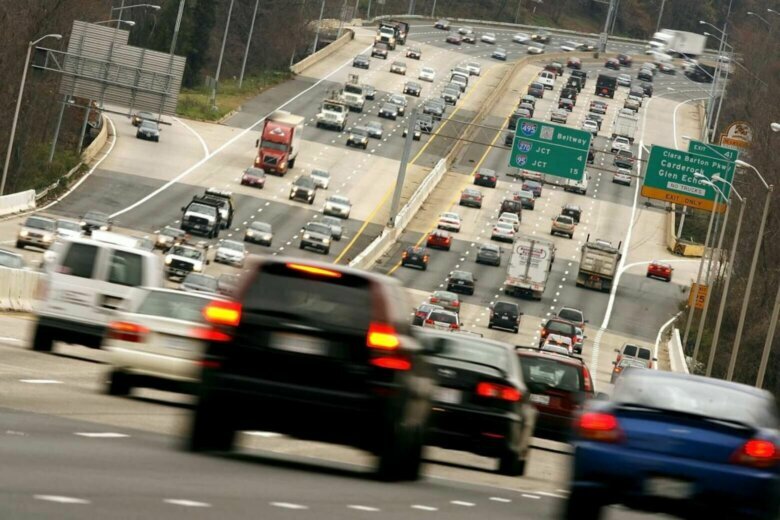This article was republished with permission from WTOP’s news partners at Maryland Matters. Sign up for Maryland Matters’ free email subscription today.

This content was republished with permission from WTOP’s news partners at Maryland Matters. Sign up for Maryland Matters’ free email subscription today.
If the Biden administration and Congress can come together on an infrastructure bill, Washington will soon be scouring the nation for aging bridges, ports, highways, rail systems and airports in need of repair.
Increasingly, opponents of Gov. Lawrence J. Hogan Jr.’s plan to widen portions of the Capital Beltway and Interstate 270 are expressing hope that the feds will find a perfect project right in their backyard: the 58-year-old American Legion Bridge, which carries I-495 traffic over the Potomac River between Montgomery County and Fairfax County, Va.
Critics of Hogan’s plan have never liked his proposed multibillion dollar “public-private partnership” — or “P3” — because of equity and environmental concerns.
From their perspective, convincing the federal government to fund the new bridge would provide the perfect escape hatch.
“Does it still make sense to do this project as a P3, with high tolls and little or no congestion relief?,” asked Gary V. Hodge, a former elected official from Southern Maryland who now runs a regional consulting firm.
“The state could pursue federal infrastructure funds to rebuild the bridge and, with its AAA bond rating, obtain the lowest-ever interest rate on capital financing for other needed transportation improvements in the corridor that have strong local government and public support,” he wrote in The Washington Post.
The changes the Hogan administration has made to the project align with what Montgomery County Executive Marc B. Elrich (D) has long advocated — scrapping the expansion of I-495 east of the I-270 spurs and starting the traffic plan at the bridge, a notorious chokepoint.
Elrich now hopes the Maryland Department of Transportation will tweak the plan some more. He suggests the state use existing pavement to add two reversible lanes on I-270 — rather than four.
And even though the Maryland Transportation Authority is set to vote on the I-495/I-270 plan’s toll structure on Thursday, Elrich thinks the state should abandon its use of private financing and “managed lanes,” where motorists can effectively buy their way out of traffic, in favor of federal funding.
There is precedent for the region turning to the federal government on a high-profile bridge.
In the late 1990s, the capital region’s congressional delegation made the replacement of the crumbling Woodrow Wilson Bridge — between Prince George’s County and Alexandria, Va., — a priority.
“Maryland’s strapped for cash,” Elrich said. “We ought to be going to the feds for the American Legion Bridge. … It makes total sense. But we need everybody to get sensible.”
In an interview, Transportation Secretary Greg Slater said Maryland has a long list of transportation assets that need attention now — or will need to be redone not far down the road.
For starters, he said, the state and Amtrak are trying to secure federal funds to rehab a 140-year-old rail tunnel in Baltimore.
But that’s just one need.
“The Baltimore Beltway was built in 1958/59,” he said. “I-95 was built around 1957. The Capital Beltway was around 1960/61. The American Legion Bridge was built in ’62.”
“Then you go a little bit further south,” he continued. “You have the Thomas Johnson Bridge. That was built in the ‘70s. Our MARC rail system was [built in the] 1980s. Light rail in Baltimore was built in ’92.”
“Much of our interstate system was built around the same time,” Slater concluded. “So it’s all kind of coming to roost at the same time.”
Slater noted that Maryland used “GARVEE” bonds — where states borrow against future federal aid — to build the Intercounty Connector, and the state created a public-private partnership to build the Purple Line.
Bottom line: The state’s decision to use private financing on the I-495/I-270 project means Maryland can pursue federal funding on its other needs, he said.
“What I’m looking at is an opportunity to use a tool on the American Legion Bridge that we may not be able to use in other parts of the system that may be as big of an infrastructure lift,” Slater said.
Rep. Anthony G. Brown (D), the only Marylander on the House Transportation and Infrastructure Committee, said it’s too early to know how big the American Jobs Plan will be. But he expressed cautious optimism that the American Legion Bridge could attract federal funding.
“The administration is going to want to look for big project gains, so we can really demonstrate to the American public and taxpayers that this money is going to big things,” he said. “The American Legion Bridge has been a big [source of] congestion for a long time.”








